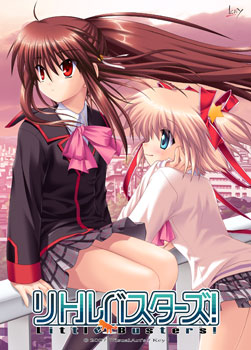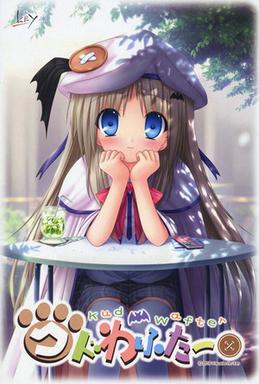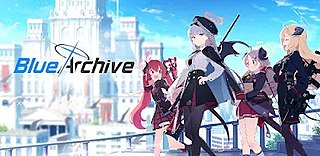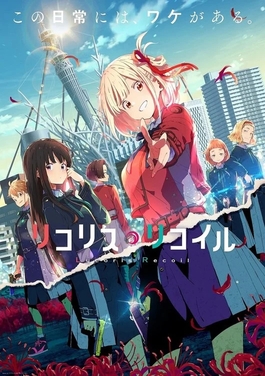
Key is a Japanese visual novel studio known for making dramatic and plot-oriented titles. It was formed on July 21, 1998, as a brand under the publisher Visual Arts, and is located in Kita, Osaka.

Clannad is a Japanese visual novel developed by Key and released on April 28, 2004, for Windows. While both of Key's first two previous works, Kanon and Air, had been released first as adult games and then censored for the younger market, Clannad was specifically made for all ages. It was later ported to the PlayStation 2, PlayStation Portable, Xbox 360, PlayStation 3, PlayStation Vita, PlayStation 4 and Nintendo Switch consoles. An English version for Windows was released on Steam by Sekai Project in 2015.

Air is a Japanese visual novel developed by Key, a brand of Visual Arts. It was released on September 8, 2000 for Windows as an adult game. Key later released versions of Air without the erotic content, and the game was ported to the Dreamcast, PlayStation 2, PlayStation Portable, PlayStation Vita and Nintendo Switch. The story follows the life of Yukito Kunisaki, a traveling showman searching for the "girl in the sky". He arrives in a quiet, seaside town where he meets three girls, one of whom is the key to the end of his journey.
Mariko Kouda is a Japanese actress, voice actress, J-pop singer and radio personality. She graduated from Kasukabe Kyōei High School and went on to major in Communications at Tamagawa University in Machida City, Tokyo, graduating in 1990. Kouda has had at least one song appear on the program Minna no Uta.

Planetarian: The Reverie of a Little Planet is a Japanese post-apocalyptic visual novel developed by Key, a brand of Visual Arts whose previous works include Kanon and Air. It was released over the Internet on November 29, 2004, for Windows, and is rated for all ages. The game was later ported to the PlayStation 2 (PS2), PlayStation Portable and Nintendo Switch, as well as mobile devices. The story centers on a man who comes across a malfunctioning robot in a dead city. The man, known simply as "the junker", stays with this robot for a time and attempts to fix the projector of the planetarium where the story takes place.

To Heart 2 is a Japanese romance visual novel developed by Leaf and published by Aquaplus. It was first released for the PlayStation 2 on December 28, 2004 as an all-ages title, and was followed by an adult version playable on Microsoft Windows and subsequent all-ages versions for the PlayStation Portable and PlayStation 3. This deviated from the release history of the game's predecessor, To Heart, which was originally released with adult content prior to receiving versions with such content removed. The gameplay in To Heart 2 follows a branching plot line with multiple endings, which offers pre-determined scenarios and courses of interaction based on the player's decisions. Its story centers on the male protagonist Takaaki Kouno, and focuses on the appeal of the female main characters.

Utawarerumono is a Japanese adult tactical role-playing visual novel developed by Leaf, which released in April 2002 for Microsoft Windows. It was ported to the PlayStation 2, PlayStation Portable, PlayStation 4 and PlayStation Vita. In releases subsequent to the initial 2002 version, it is known by its more specific title Utawarerumono: Prelude to the Fallen.

Otome wa Boku ni Koishiteru, commonly known as Otoboku (おとボク), is a Japanese adult visual novel developed by Caramel Box and released on January 28, 2005 playable on Windows PCs. The game was later ported to the PlayStation 2 and PlayStation Portable (PSP) with the adult content removed. The Windows version was released in English by MangaGamer in 2012. The story follows the life of Mizuho Miyanokouji, an androgynous male high school student, who transfers into an all-girls school due to his grandfather's will.
Kanon is a visual novel developed by Key and published by VisualArt's in 1999. The story follows Yuichi Aizawa, who has returned to the town where seven years ago he would spend his school vacations, but has forgotten many of the details regarding his previous visits. Over the course of the series, Yuichi slowly regains these memories as he meets new friends and is reacquainted with others from his past. It was adapted by Toei Animation into a 13-episode anime television series broadcast in 2002 along with an accompanying original video animation episode released in 2003, both directed by Takamichi Itō with music direction by Hiroyuki Kōzu. Kyoto Animation also adapted it into a 24-episode anime television series broadcast between 2006 and 2007 directed by Tatsuya Ishihara with music direction by Shinji Orito. The discography of Kanon and its anime adaptations consists of one compilation album, three singles, three soundtracks, and three remix albums.

Little Busters! is a Japanese visual novel developed by Key. It was released on July 27, 2007 for Windows PCs and is rated for all ages. Little Busters! is Key's sixth game, along with other titles such as Kanon, Air, and Clannad. An adult version of the game titled Little Busters! Ecstasy was released on July 25, 2008 for Windows, unlike Kanon and Air, which were first released with adult content and then had later versions with such content removed. Ecstasy was later ported to the PlayStation 2, PlayStation Portable, PlayStation Vita, PlayStation 3, and Nintendo Switch with the adult content removed under the title Little Busters! Converted Edition. An English version for Windows was released on Steam in 2017. The story follows a group of childhood friends now attending high school called the Little Busters, as they decide to form a baseball team. Riki, who is diagnosed with narcolepsy, is tasked to recruit more girls in preparation for a baseball game, and he bonds with each of them on account of their internal conflicts. Meanwhile, Rin gets mysterious letters from her cat Lennon to complete various tasks to learn the "secret to this world".

One: Kagayaku Kisetsu e is a Japanese adult visual novel, developed by Tactics, a brand of Nexton, released on May 29, 1998 playable on Windows PCs. The erotic content was later removed when the game was ported to the PlayStation. The story follows the life of Kōhei Orihara, a high school student who has fun spending time with several girls about his age, while at the same time he is gradually being drawn into a mystical alternate space known as the Eternal World.

Jun Maeda is a Japanese writer and composer. He is a co-founder of the visual novel brand Key under Visual Arts. He is considered a pioneer of nakige visual novels, and has mainly contributed as a scenario writer, lyricist, and musical composer for the games the company produces.

Rewrite is a Japanese visual novel developed by Key, a brand of Visual Arts. It was released on June 24, 2011 for Windows PCs and is rated for all ages. Rewrite is Key's ninth game, following other titles such as Kanon, Air, and Clannad. Key released a fan disc expanding on the game's story titled Rewrite Harvest festa! on July 27, 2012 for Windows. Rewrite was ported to the PlayStation Portable, PlayStation Vita, PlayStation 3 and PlayStation 4, while Harvest festa! was ported to the PlayStation Vita. An English version of Rewrite for Windows was released by Sekai Project in 2021; they will also release Harvest festa! in English. The story follows the life of Kotarou Tennouji, a high school student with superhuman abilities who investigates supernatural mysteries with five girls from his school in the fictional city of Kazamatsuri. This ultimately leads him into the middle of a conflict between familiar summoners and superhumans with the fate of the world at stake.

Kud Wafter is a Japanese adult visual novel developed by Key, released on June 25, 2010, for Windows. Kud Wafter is Key's eighth game, along with other titles such as Kanon, Air, and Clannad. Key released a version of Kud Wafter without the erotic content, and the game was ported to the PlayStation Portable and PlayStation Vita. The story follows the lives of high school students Riki Naoe and his close friend Kudryavka Noumi as they start to see more of each other in a romantic relationship. The gameplay in Kud Wafter follows a branching plot line which offers pre-determined scenarios with courses of interaction, and focuses on the appeal of the title character Kudryavka, also known as "Kud" for short.

A Good Librarian Like a Good Shepherd, known in Japan as Daitoshokan no Hitsujikai, is a Japanese adult visual novel developed by August and released on January 25, 2013 for Windows as a DVD. The gameplay in Daitoshokan no Hitsujikai follows a branching plot line which offers pre-determined scenarios with courses of interaction, and focuses on the appeal of the five female main characters by the player character. A fan disc for Windows titled Daitoshokan no Hitsujikai: Hōkago Shippo Days was released in August 2013. A second, adult fan disc titled Daitoshokan no Hitsujikai: Dreaming Sheep was released in March 2014. A PlayStation Vita port of the original game and fan discs featuring additional content was released in February 2015.

Planetarian: Storyteller of the Stars is a 2016 Japanese animated post-apocalyptic film directed by Naokatsu Tsuda. The film is based on the Planetarian: The Reverie of a Little Planet visual novel by Key and the "Man of the Stars" short story from the Planetarian light novel written by Yūichi Suzumoto. The film was animated by David Production and distributed by Asmik Ace. It premiered in Japanese theaters on September 3, 2016. The story is set in a dystopian future where nuclear warfare has left a once prosperous civilization in complete ruin. The film tells the story of an old man traveling around with a mobile planetarium projector to show people the stars.

Blue Archive is a South Korean role-playing game developed by Nexon Games, a subsidiary of Nexon. It was released in 2021 for Android and iOS, first in Japan by Yostar and worldwide later that year by Nexon. The game is free-to-play with gacha game mechanics as a means to obtain new characters. An anime television series adaptation titled Blue Archive The Animation premiered in April 2024.

Lycoris Recoil is a Japanese original anime television series created by Spider Lily and Asaura. It was produced by A-1 Pictures and aired from July to September 2022. Set in Tokyo, Lycoris Recoil follows two young orphaned teenage girls named Chisato Nishikigi and Takina Inoue, who were recruited in the Direct Attack organization to carry out assassinations under the "Lycoris" program while they work at a local café and performed various tasks such as childcare, shopping, and teaching classes.




















